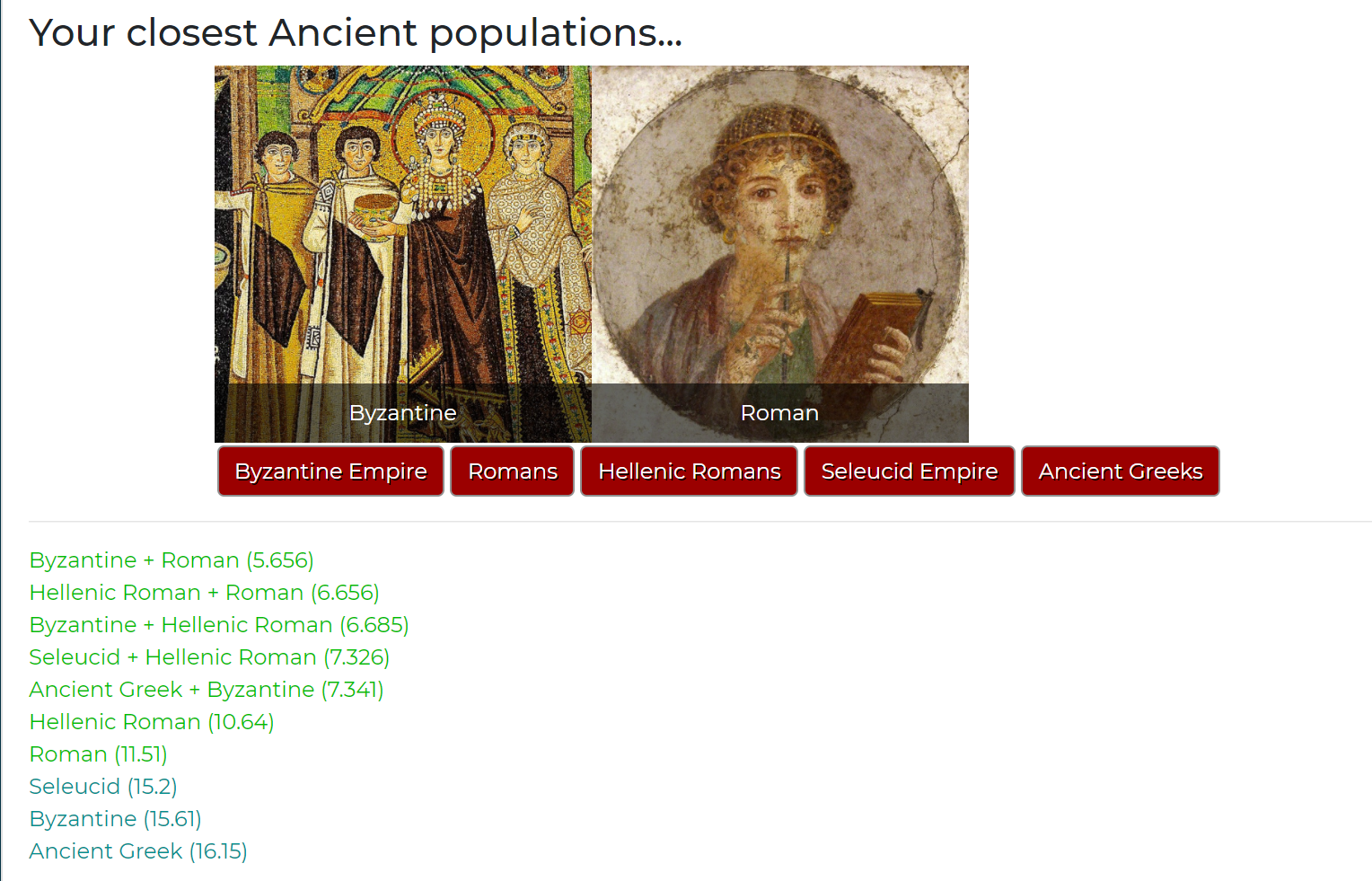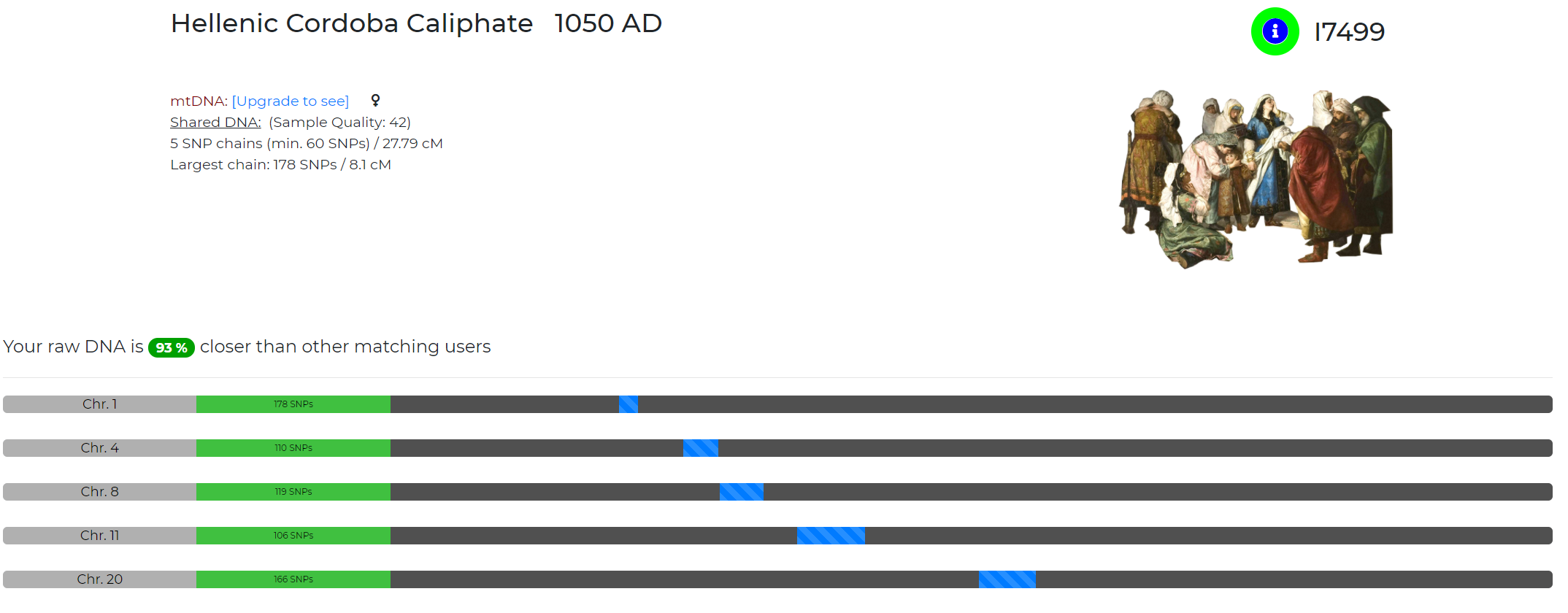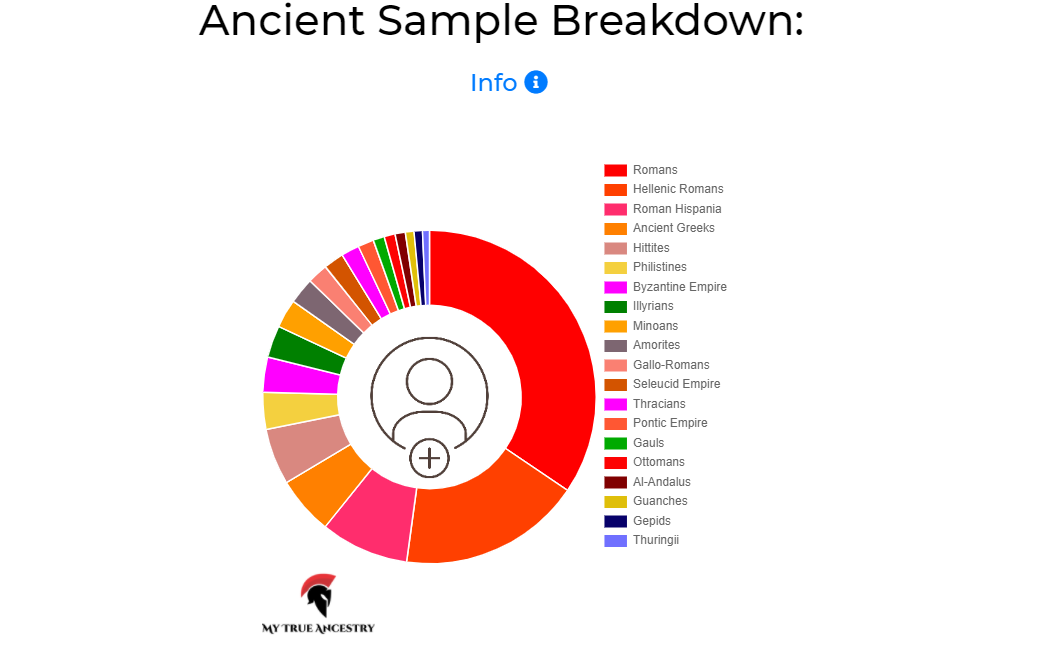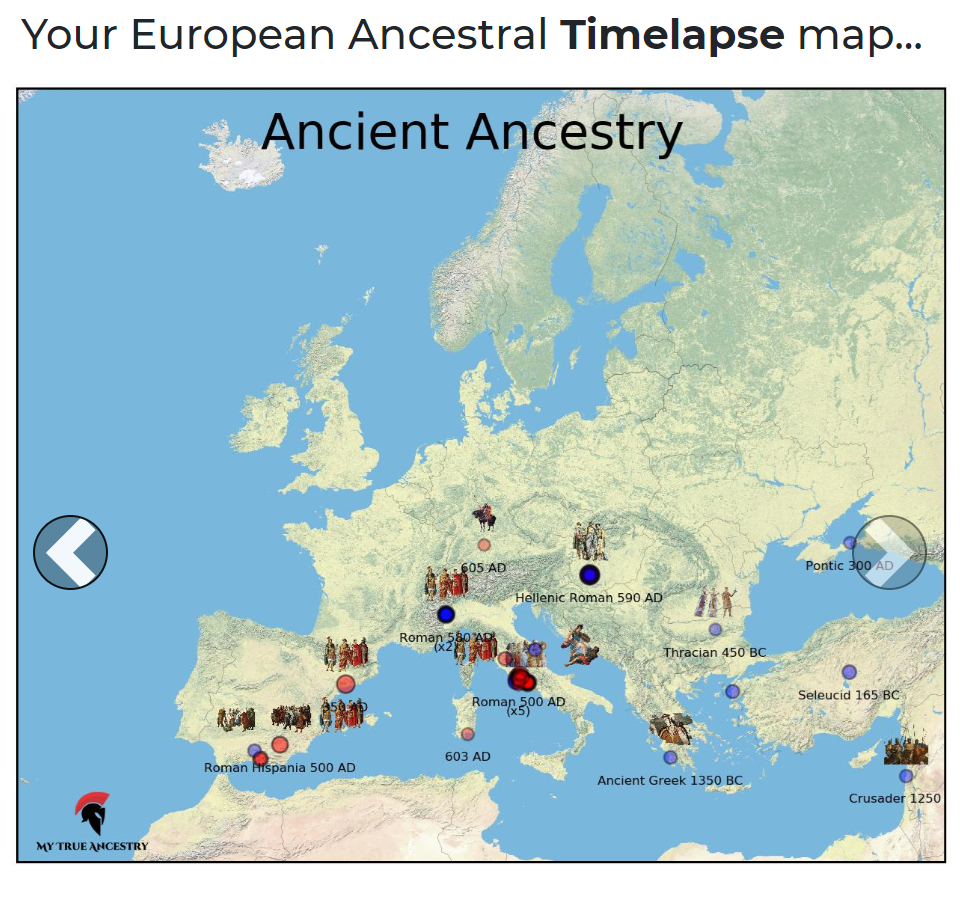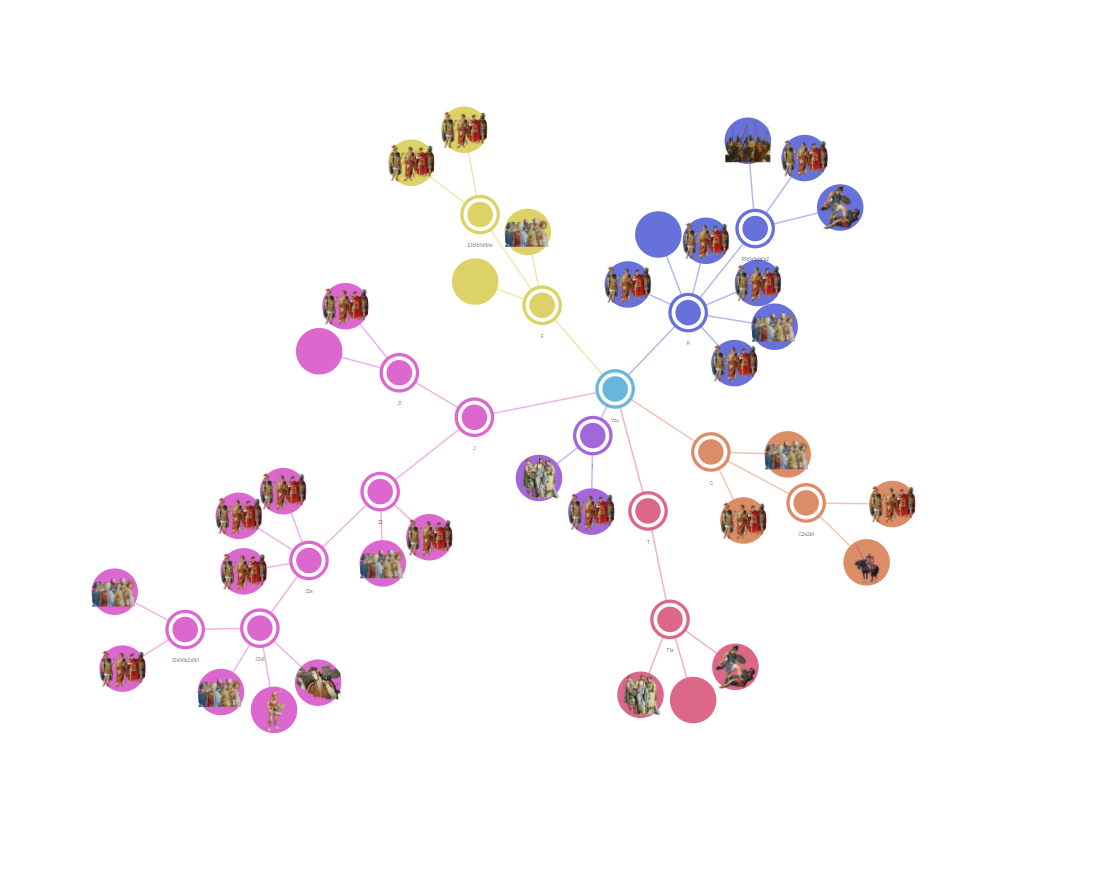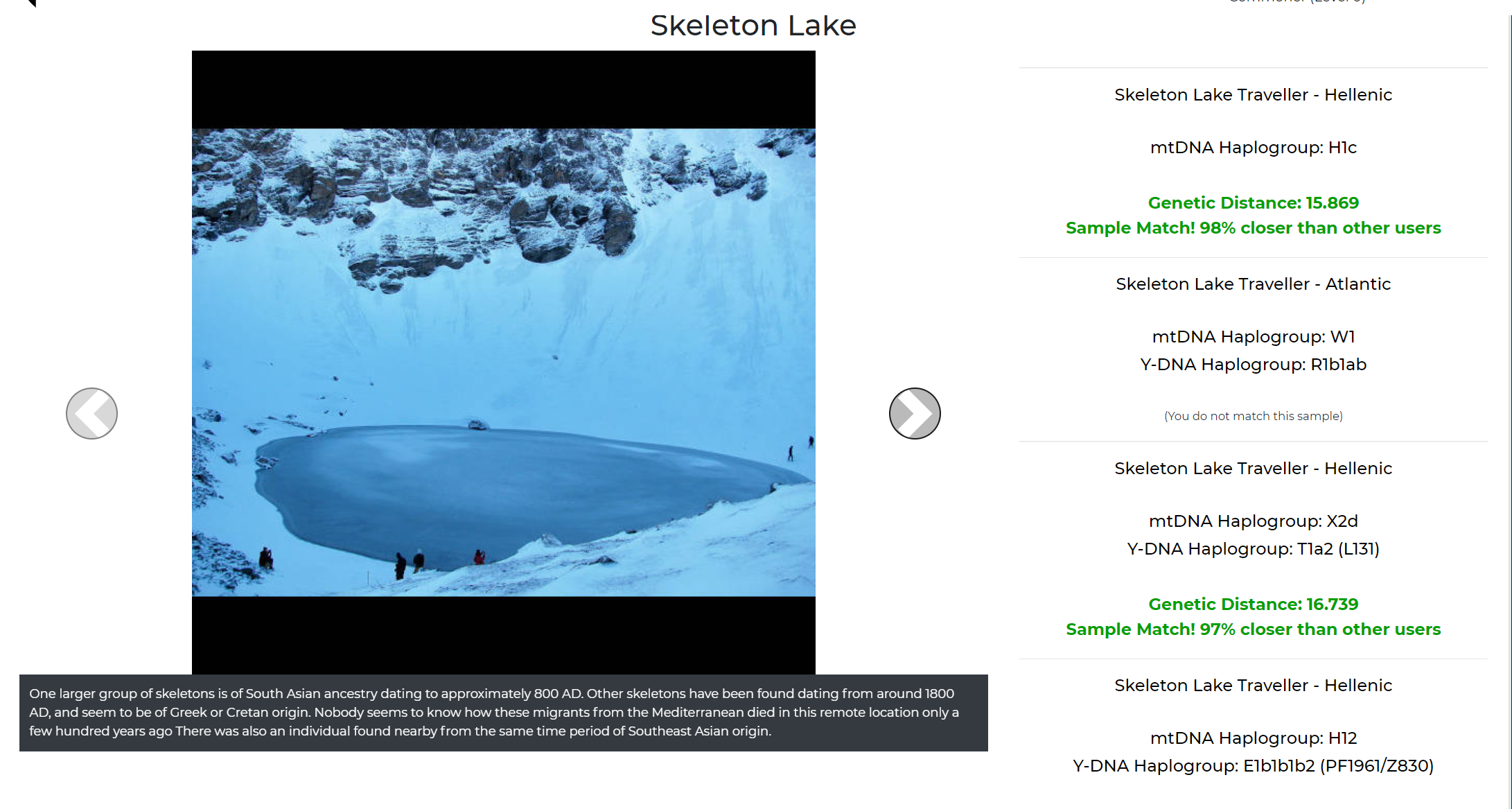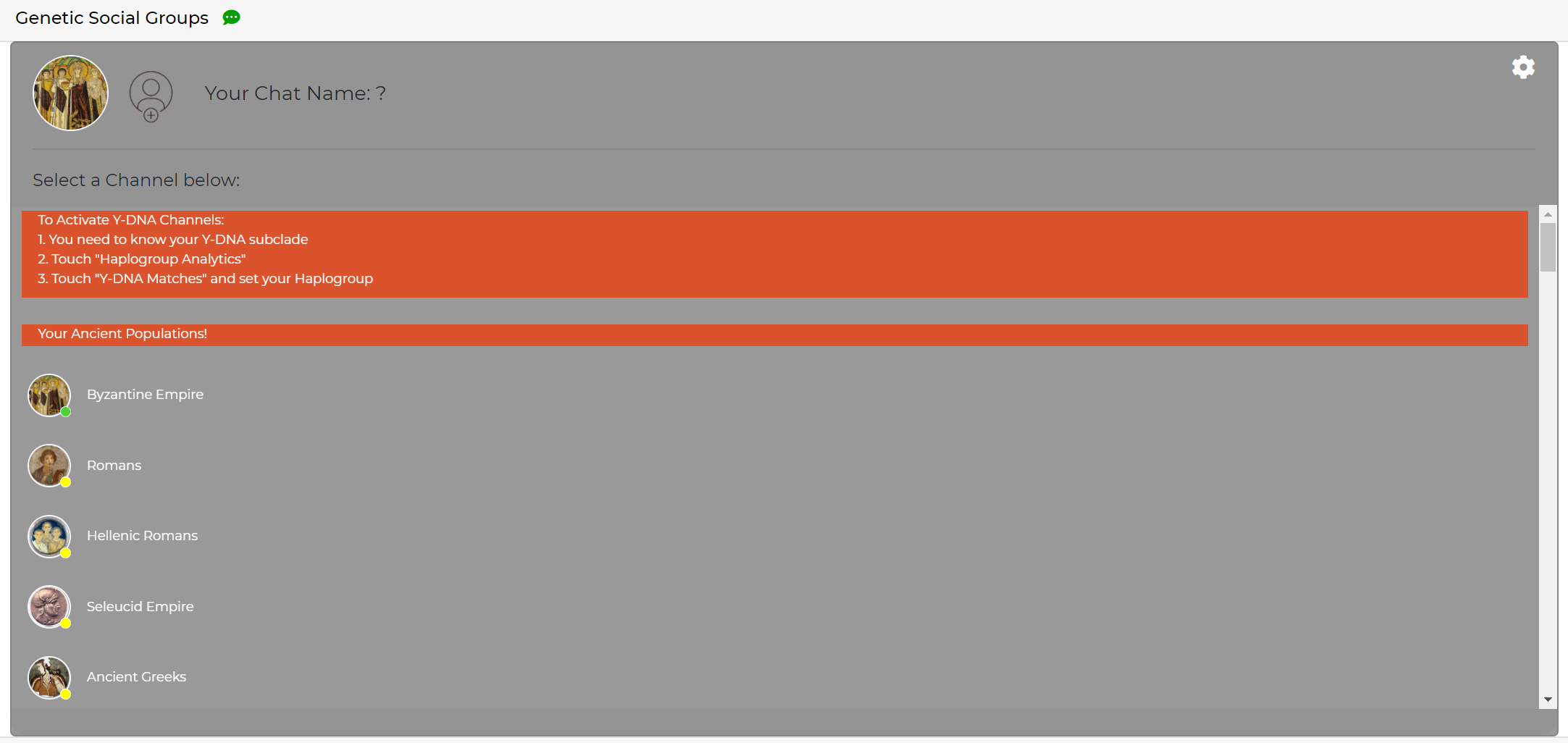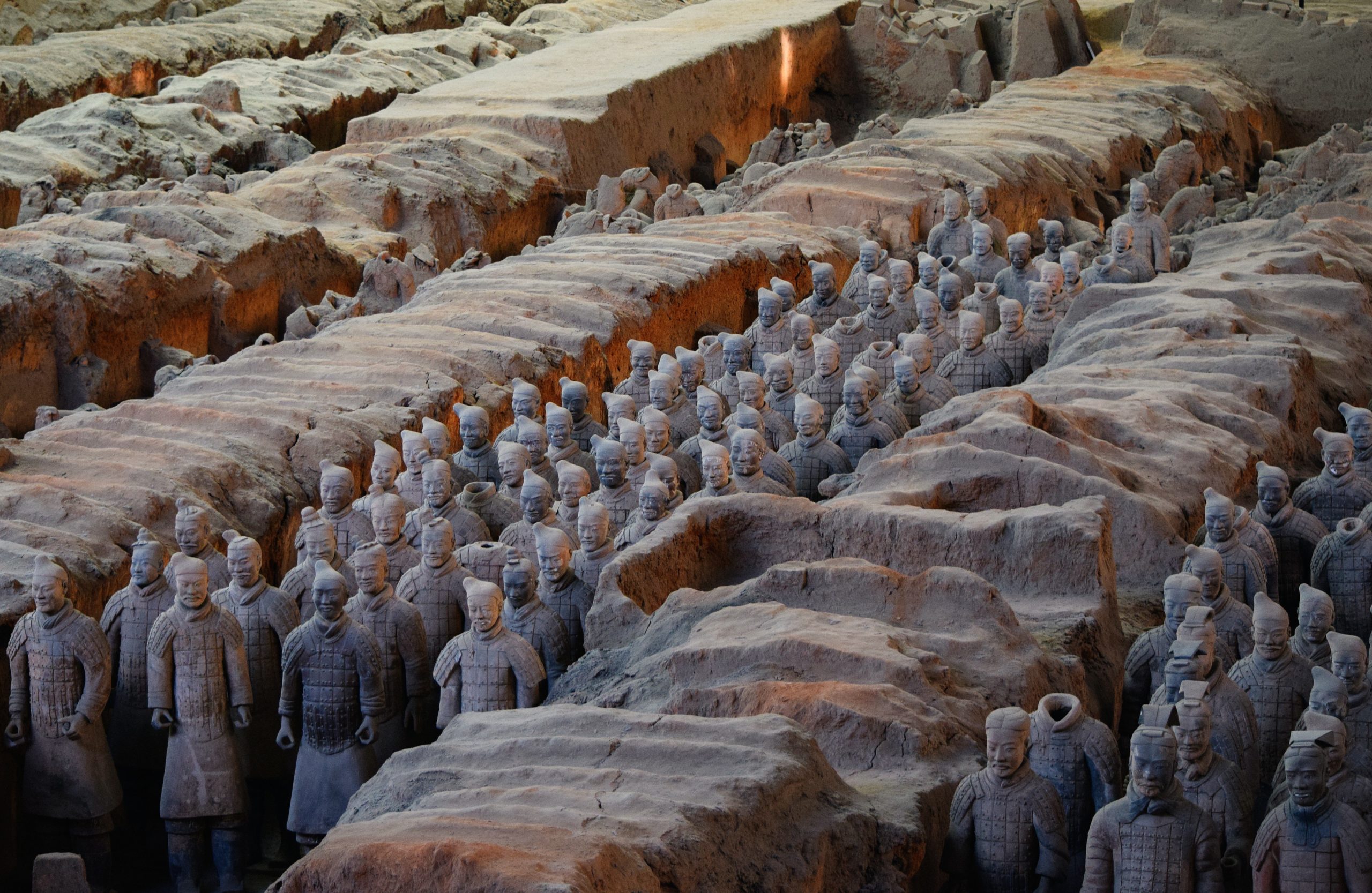
Overview
- Products: MyTrueAncestry uses customers’ existing DNA files that they’ve obtained from other genetic testing services to carry out an in-depth analysis of their genetic history. Users can observe relationships between their own DNA samples and those of a number of ancient populations.
- Cost: $0-$596 – MyTrueAncestry provides several levels of analysis which vary in the number of ancient samples they compare an individual’s DNA to, how many genome files a user can upload, and the detail and presentation of the reports.
- Reports: The level of detail and the customizability of MyTrueAncestry’s reports varies based on the level of service which the user has paid for. All the reports contain chart visualizations which convey ancestry data of the users samples, but in more advanced service levels reports also include genealogical maps which can be altered to display different time periods.
- Raw Data Access: MyTrueAncestry does not provide users with raw access to their data, as users must have already acquired their raw genetic data file from a different service provider in order to use their service.
- Privacy: MyTrueAncestry is uniquely committed to the privacy and security concerns of their clients; at no point do they require users to enter any kind of personal information other than the genetic data file upload which is required to carry out ancestral analysis.
- MyTrueAncestry Alternatives: SelfDecode (comprehensive, individualized, and clinically relevant genetic reports and wellness recommendations), MyHeritage (ancestry analyses for which test kits are provided), Ancestry DNA (genealogy oriented genetics tests which assess based on geography and ethnicity).
MyTrueAncestry Pros & Cons
Pros
- MyTrueAncestry uses existing raw genetic data files by default. This means their base level service is freely available to anyone who has already had their DNA tested using a separate service.
- MyTrueAncestry’s commitment to privacy and security is extensive. Because they do not require their users to enter any personal information, clients never create a set of identifiable data which could be traced back to them. They even acknowledge and encourage users to use an anonymous email account should they feel the need.
- The variety of payment levels that MyTrueAncestry provides means that they can cater to an increased audience, including both amateurs who are merely curious about their ancestry information and users invested in more serious, individual research regarding their genealogy.
Cons
- On the flip side, because MyTrueAncestry does not provide an in-house testing service users who have not already had their DNA tested will have to outsource their kit purchase to a different genetics testing company.
- The processes which MyTrueAncestry uses to compare its users’ genetic data to archeological samples, most of which are publicly available through research data, is somewhat unclear. Some independent reviewers have questioned the legitimacy of the methodologies they employ.
- Some of the higher levels of service which MyTrueAncestry provides are considerably expensive, and while the tools they provide have the potential to be very valuable to some users, only clients with a certain amount of genealogical experience will be able to reap their full benefits.
- Although a profound resource for ancestry oriented genetics, MyTrueAncestry does not provide any genetic analysis which is health or wellness oriented, unlike some other services which do offer more actionable genetic assessments.
About MyTrueAncestry
MyTrueAncestry doesn’t have any publicly available information about their founders, staff, or potential ties and partnerships. Their commitment to privacy is reflected even in their available descriptive information or lack thereof. They are based out of Switzerland and have a corporate email address which users can contact should they wish to learn more information about the company.
Their corporate information site states that their founder is a well published and reputable MIT graduate who had his ancestral DNA tested by a major genetics company and was disappointed with the simplicity of the results he received, and so the seed for MyTrueAncestry was planted. They attest that their team is made up of industry veterans, genealogists, technologists, DNA experts, and Data Security Specialists, some of whom are graduates of MIT, Harvard, and Yale.
Overview of MyTrueAncestry Testing
Even with the most minimal package (commoner, which costs the user nothing except what they may have paid to have their DNA originally tested), MyTrueAncestry provides users with a significant amount of information. Clients can view their ancestral genetics as compared with a number of archaeological samples which vary based on what level of access the user has purchased. The genially and aptly named levels of access are as follows:
Commoner ($0) – Compares DNA to 10 different ancient samples, provides access to timelines and basic maps.
Footman ($37) – Compares DNA to 20 different ancient samples, provides access to timelines, basic maps, 2D PCA plots, and genetic social groups.
Knight ($55) – Compares DNA to 40 different ancient samples, provides access to timelines, basic and premium maps, 3D PCA plots, and genetic social groups. Users can also upload a second DNA kit at this level.
King ($100) – Compares DNA to 60 different ancient samples, provides access to timelines, basic, premium, and archaeological maps, ‘deep dive’ results, regional archaeogenetics, 3D PCA plots, and genetic social groups. Users can upload up to 5 kits at this level.
Caesar ($149) – This level provides everything which the King level provides but in addition, users receive a more in-depth sample analysis and gain access to something called ‘Haplogroups’ which are genetic populations of people who share the same ancestor. Users can upload up to 10 kits at this level.
Zeus ($248) – The Zeus level is synonymous with the Caesar level except that users now have their DNA compared to over 100 ancient samples and have the ability to make customizable genetic maps in real time.
Olympus ($397) – The Olympus level is intended for users who have an existing knowledge base and passion for ancestral, genetics based research. DNA is compared to over 150 ancient samples, users can upload up to 15 data kits, and they have the unique ability to create customizable kits from archeological samples.
Odyssey ($596) – This level differs from Olympus in that it compares users’ DNA to over 250 total ancient samples, and users can upload up to 25 DNA data kits.
Even at the Commoner level, users are shown a preview of features only available to higher levels so that clients who are new to MyTrueAncestry’s reporting can grasp what functionality might be desirable for them.
Review of MyTrueAncestry Test Reports
The MyTrueAncestry DNA reports display comparisons of the user’s genetic data to a predetermined selection of ancient DNA samples in order to display genealogical connections the individual might share with known historic populations. The user’s genetic data is compared to a variety of other ancient samples, varying in number based on the level of access the user has purchased.
The comparisons are then viewable through a number of different platforms such as timelines, maps, ‘deep dives’ which provide a more complex analysis, and even genetic social groups which assemble other MyTrueAncestry users who share similar relationships to the user. Below is the most basic visualization, a listed comparison of the closest related ancient populations to the user, which in this case includes the Romans and the Byzantine Empire. A smaller number next to a population indicates a closer genealogical relationship.
Within the summary pages, users can also view their archaeogenetics matches sorted by era, their closest genetic matches to modern populations, and their ‘deep dive’ results which go as far as to reflect the number of SNPs a user shares with various ancient populations.
At higher access levels, users can customize the threshold of SNPs which qualifies a genetic match with a given population. An example, which reflects a relationship with the Hellenic Cordoba Caliphate, is shown below.
MyTrueAncestry provides a variety of ways that users can visualize the comparisons revealed by their analysis in graphs, maps, and PCA plots, which show clusters of ancient samples grouped based on their similarity. These illustrations only become more in depth and customizable as users increase their level of access. Below is the basic graphic representation viewable for users at the commoner level.
Users can also access a topographic visualization of their ancestral relations, which includes 2D or 3D maps that illustrate where the ancient populations relevant to the user existed and flourished. A European ancestral time lapse map is shown below, however maps for Africa, Asia, and the Americas are also available. Multiple maps can be viewed which change the populations shown based on the time period in which they were present.
Another interesting visualization that the test reports provide is a set of manipulatable, networked circles that visualize a user’s haplogroups. This function allows users to see not only which comparative ancient samples are relevant to them, but also how those samples relate to each other and how many degrees of separation exist between them. The haplogroup is shown below.
Additionally, the reports include something called a DNA spotlight, which uniquely identifies specific archeological sites for which users have a significant genetic relationship. The DNA spotlight also shows specific individuals of historical significance (the demo analysis noted Jean-Paul Marat and King Louis XVI), smaller populations, and historical periods or events to which the user has some kind of genealogical connection. Each relation of significance is accompanied by a general description as well as a selection of pictures.
A final feature of note is access to ‘genetic social groups,’ once again depending on the level of service which the user has purchased. This allows users to join various chat rooms based on haplogroups, relevant populations, or ‘deep dive groups’ and speak with other users who theoretically share some form of deeply seated genealogical connection. The heading above the group types muses: “Meet your ancient cousins!”
MyTrueAncestry Cost
As described above, the variation in cost, depending on the level of analysis users are looking to gain from MyTrueAncestry, is significant. One advantage of MyTrueAncestry’s service is that at the commoner level, for which users pay nothing, the potential visualizations and functions available to them at higher entry levels are visible, though the actual content is hidden. This does allow users of MyTrueAncestry to gain a clearer understanding of the type of analysis available to them, and therefore more accurately assess what service level might be appropriate for them, before making a purchase.
The authentic cost of MyTrueAncestry’s service should be considered as the combined cost of the actual access level that the user purchases as well as the original price of ordering a DNA test kit. This typically runs anywhere from $50-$150, but it is critical to ensure that the company one selects provides access to raw genetic data rather than simply analyzing it for the sake of their in-house tests.
Finally, some of the gaps in access levels feature far larger price discrepancies than others. It is only $30 to upgrade from the knight to the king level, but to upgrade to Olympus from Zeus, that figure changes to just under $200. Is the ability to customize raw DNA kits worth that much? To some users who are deeply passionate about genetic analysis, perhaps, but to others, probably not.
How scientific is MyTrueAncestry’s ‘ancient ancestral analysis’?
Some anecdotal reviews alluding to MyTrueAncestry around the web claim that the service simply seems ‘too good to be true’ and that the extent of comparison they carry out against archaeological samples simply isn’t plausible. The FAQ section of MyTrueAncestry’s site sheds some light on how they are able to execute the ancient analysis they do. MyTrueAncestry retrieves its raw comparative samples from public databases which are available to the public. They note that many of these samples are of poor quality but that it is still possible to glean valuable information from these samples using ‘advanced techniques.’
They also explain in a more basic context that ‘ancient DNA’ consists of samples retrieved from archeological digs such as, for example, a human tooth. The DNA is then scanned from these samples in a complex process aligning the genetic data with the human genome. Finally, MyTrueAncestry says that they can accurately compare anyone’s genetic information with a wide selection of ancient samples by combining the ‘latest archaeogenetic techniques with powerful admixture algorithms and cloud computing.’ They also note that their process makes significant use of ‘triangulation and clustering.’ While these buzzwords certainly sound complex, they don’t indicate anything understandable about MyTrueAncestry’s scientific processes. While the methodologies MyTrueAncestry employs may be entirely scientifically legitimate, their details remain a mystery.
MyTrueAncestry Results: Genealogy vs. Health
MyTrueAncestry obviously provides a service which is neither health nor wellness focused, unlike many other genetic testing services. They are entirely genealogically focused and they provide information which could be construed as less critical to the well-being of their clients than, say, the knowledge that one has a particular genetic predisposition to a type of hereditary cancer. That being said, the service which they advertise to clients is the service they provide: Users are able to access an exhaustive and expansive analysis of their ancient ancestral genetic relationships, and have the ability to manipulate and view that data in a variety of ways.
While this is adequate and, indeed, beneficial for users looking to use their DNA kits merely for recreational engagement, there are more impactful and certainly significant ways in which individuals can make use of their genetic information. Ancestry is excellent, but other genetics analysis services can offer individuals more actionable insights about how their biology affects their habits with respect to wellness, health, and their overall lifestyle. While dismissing nothing about the possible benefits that might be reaped from those who are passionate about ancestral analysis, this type of instruction has the potential to have a more poignant effect on users.
Review of MyTrueAncestry Privacy and Security
As was briefly touched on before, MyTrueAncestry takes a firm stance on the privacy and security of their clients. At no point does the service require you to enter any type of personal information, excluding the email with which a user’s account is created. Given, the DNA file which is uploaded is a wealth of personal information about the user, however, without any other connected personal data, the genetic file is not identifiable to the person who uploaded it. This offers a significant level of privacy to users, even in the initial stages of MyTrueAncestry’s service.
Further, MyTrueAncestry makes clear that although genetic information is stored within the cloud for users who opt for paid access, the DNA kits of all clients are deleted from their servers after the information has been processed. Clients also have the ability to request immediate deletion of their data as well as their account and login information at any-time. Essentially, MyTrueAncestry’s approach is to ask their clients for as little information as necessary to still be able to carry out effective analysis, thus keeping their identities secure.
Partnerships
MyTrueAncestry apparently has no partnerships nor affiliations to speak of, primarily because the identity of their staff group, founder(s), and CEO is a mystery. Given their obvious commitment to the security of users’ information, it seems evident that their collective belief about the importance of privacy is personal and deeply held.
SelfDecode vs MyTrueAncestry
- SelfDecode provides its clients with a prominent and constantly updated set of health and wellness recommendations that are meant to serve as actionable steps which users can take to apply knowledge about their biology to their everyday lives. MyTrueAncestry opts to reveal genealogical information to its users which, though interesting and perhaps enriching, isn’t as pragmatic.
- SelfDecode directly integrates the science that supports its conclusions into the reports and analyses that are made available to clients so that they can understand precisely what goes into their genetic evaluation. MyTrueAncestry provides the names of some of the methodologies they use to do comparative analysis of ancient samples, but the science behind these processes is somewhat murky.
- SelfDecode seeks to provide users with information that is of the most significance to them; they give special priority to health and recommendations which they assess as being of particular importance so that customers receive the most critical information first. With MyTrueAncestry, not all of one’s important genealogical information is immediately available. Users might be excited to learn about a particular aspect of comparison of their genetic background, only to find that it is exclusive to a higher access level.
- SelfDecode takes a characteristically holistic approach to genetics based health and wellness, seeking to make the user experience, as well as the information they receive, as well-rounded and widely applicable as possible. MyTrueAncestry is more narrowly focused on ancestry, which can help users understand their history but fails to help them optimize their present lifestyle.
- SelfDecode has the only constantly updating and personalized genetics blog of its kind. It is an entirely unique tool geared towards giving users the most up-to-date and biologically relevant health and wellness instruction. MyTrueAncestry does provide updated comparison as more archeological samples become available to its database, but while this might give users a new metric for comparison, it doesn’t offer any actionable behaviors.
- SelfDecode uses testing processes that are extremely detailed, analyzing up to 83 million genetic variants in order to provide genetics analyses to their clients that are entirely comprehensive. At its highest level of access, MyTrueAncestry compares user’s data to up to 250 archeological samples.
- SelfDecode backs up all of the conclusions it makes with clinically reputable research, all cited directly within the reports so that users have a direct link to the science that supports their assessment. MyTrueAncestry gets its archaeological samples from publicly available research databases, but doesn’t offer the names of these databases nor their credentials.
- SelfDecode never, under any circumstances, shares user information with any outside companies or third parties. MyTrueAncestry also makes a staunch commitment to security, and doesn’t require users to submit any identifiable information along with their genetic test kit.
Comparisons
| SelfDecode | MyTrueAncestry | MyHeritage | AncestryDNA | |
|
Comprehensive personalized holistic health recommendations |
Yes | No | No |
Minimal wellness instruction |
|
Personalized blog posts |
Yes | No | No |
No |
|
Products |
DNA testing, wellness reports, research-based personalized blog posts, health recommendations, direct-to-consumer test kits | DNA analysis, genealogical reports, ancient genetic sample comparisons, detailed population visualizations | DNA testing, ancestral genealogical testing, ethnicity estimates, family tree construction |
DNA testing, ancestral genealogical testing, ethnicity estimates, health reports |
|
Raw data access |
Yes | N/A | Yes |
Yes |
|
Cost (USD) |
$97 – $297 | $0 – $596 | $49 – $349 |
$99 – $149 |
MyTrueAncestry Reviews
Nebula Genomics – 4.7 of 5 Stars
Nebula Genomics commends MyTrueAncestry for how unique their services are as well as for their strict commitment to client privacy and security of information. MyTrueAncestry does have a discount deal structured with Nebula for clients who use their test kit services.
Genomelink
The editors at Genomelink highlighted more general skepticism about the value of ancestry DNA testing in general, questioning the value of the information provided by MyTrueAncestry’s analysis. However, they had no particular bones to pick with the service or reports themselves.
Read what people are saying about MyTrueAncestry on Reddit
Some Reddit users are skeptical about the validity of MyTrueAncestry’s practices, specifically their ability to achieve valid archaeological samples for comparison.
Read what people are saying about MyTrueAncestry on Facebook
The MyTrueAncestry Facebook page is consistently active with the admins posting factoids, stories, and historically relevant descriptions of ancient populations. The client reviews on the page are overwhelmingly positive.
Alternatives to MyTrueAncestry
SelfDecode – SelfDecode’s service is for individuals seeking a window into their own biology along with a variety of health, wellness, and lifestyle recommendations, or for professionals looking to improve their ability to assess treatment options. Outside the realm of ancestry testing, SelfDecode provides everything else one could want to get out of a genetic analysis.
MyTrueAncestry Review Summary
MyTrueAncestry legitimately provides a unique service in the field of ancestry and genealogy; not many, if any, other companies are working to provide clients with a direct comparison to the ancient populations with which they might share a genetic relationship. It’s possible that part of the reason why they are able to operate so independently is because of the existing skepticism that surrounds such research. It is still unclear precisely how accurate, valuable, or effective the type of comparative analysis that MyTrueAncestry carries out is, and their methodology is equally obscure.
The structure of MyTrueAncestry’s service is intuitive and customer friendly. Providing a free, base level experience to their clients allows users to get an authentic grasp of the scope of the programs they provide, and therefore, make an educated decision about what level of access they’d like to assume. For individuals who are extremely engaged and passionate about their genetic ancestry, MyTrueAncestry provides some extremely nuanced and cool tools in order to view and manipulate those relationships. That being said, genetic analysis has a vast potential, not just for recreational purposes, but for creating substantial, life changing awareness of one’s own biology. MyTrueAncestry doesn’t intend to provide users with this level of understanding. Different services for example, SelfDecode, intend to do just that.

